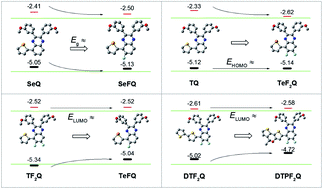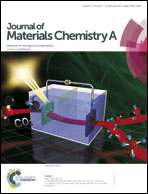Computational modelling of donor–acceptor conjugated polymers through engineered backbone manipulations based on a thiophene–quinoxaline alternating copolymer†
Abstract
The rapid progress of bulk heterojunction organic photovoltaics has been boosted by (i) design and synthesis of novel conjugated donor materials, (ii) control and optimization of device fabrication, and (iii) the development of new device architectures such as tandem and ternary solar cells. Computationally driven material design has attracted increasing interest to accelerate the search for optimal conjugated photovoltaic materials, and the exploration of chemical methodologies is highly desirable in pushing the efficiency further towards the theoretical limit. Based on the motif of donor–acceptor polymers, around 50 comparable polymers were constructed and investigated, derived from an easily accessible thiophene–quinoxaline alternating polymer donor showing power conversion efficiency up to 7%. We performed a systematic density functional theory (DFT) study on the heteroatom effects of combining fluorine, nitrogen and chalcogen substitutions onto the donor/acceptor units as well as the effect of extending π-conjugation in the donor moiety, in order to gain insight into how structural modifications to the conjugated backbone can affect the molecular structure and electronic properties of a conjugated polymer. It is found that the trends in the energy levels and band gaps of these polymers correlate well with their structural modifications. Finally, by examining the systematically evaluated data in the energy diagram, we proposed three important ways of energy level modulation, showing potential chemical methodologies that can be applicable to further modify and optimize existing polymer backbones. Especially such energy level modulation can be applied to meet the particular requirements of different device architectures (including tandem and ternary solar cells) on the donor components, such as a prominent photocurrent or photovoltage combined with a high efficiency, to further maximize the overall performance of organic photovoltaics. This will provide valuable guidance and chemical methodologies for a judicious material design of conjugated polymers for solar cell applications with desirable photovoltaic characteristics.


 Please wait while we load your content...
Please wait while we load your content...